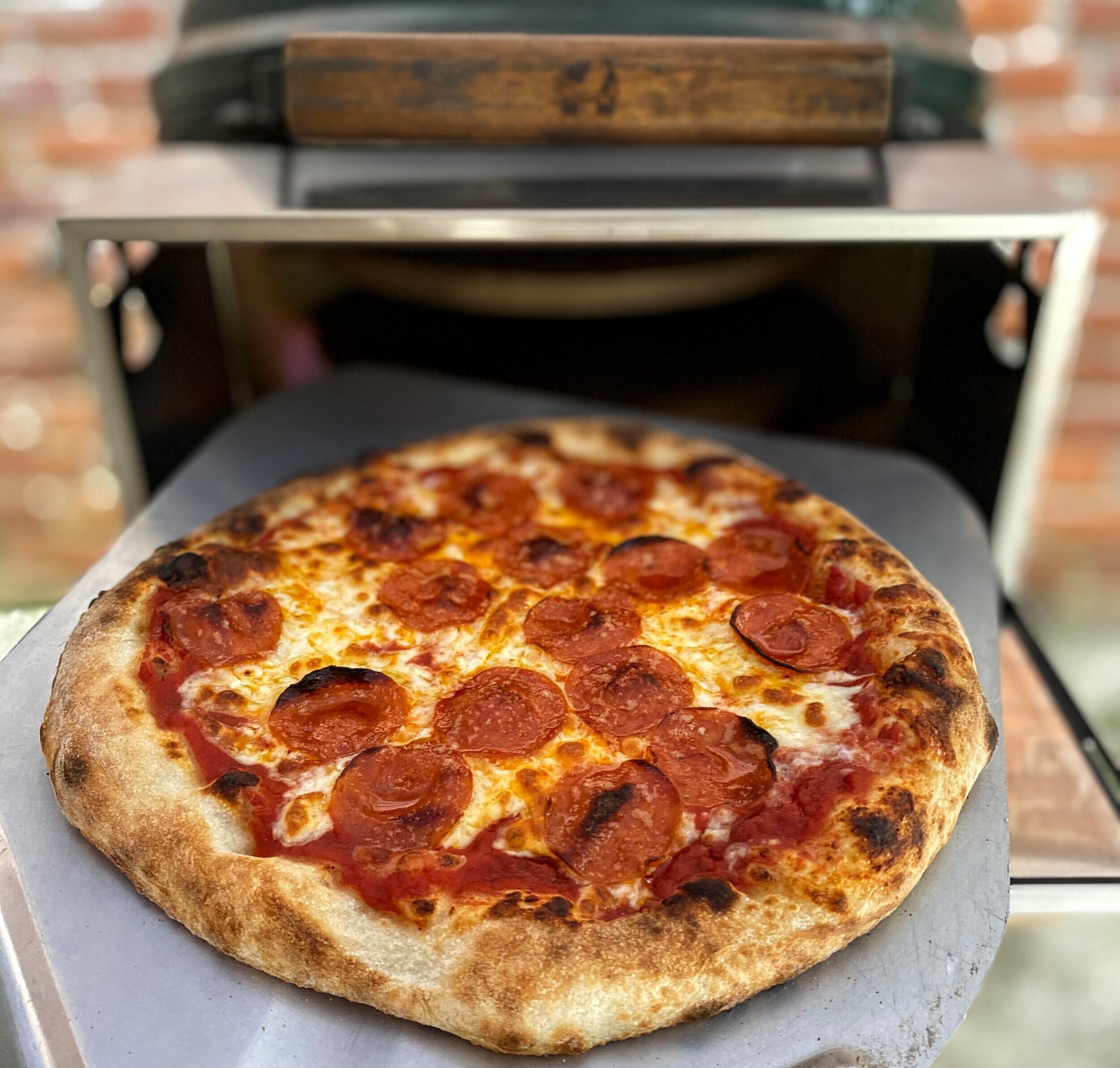How-To: first Pizza-Porta cook.
So you have a new Pizza-Porta and want to enjoy your first pizza night. Congratulations! Here is a complete plan to get started. This plan is laid out very specifically with 4-5 of our favorites for pizza night. Once you are comfortable with your new pizza oven this will become second nature.
Shopping list for Pizza Topping Ingredients for this night:
Remember you only need enough of each for 1-2 pizzas. Here is a shopping list:
1 package - 4 oz of prosciutto
1/4 lb thin sliced pepperoni
1 can of whole San Marzano tomatoes DOP. Crush them by hand, add salt, chopped basil and pepper to taste. (or - 1 jar of Delallo pizza sauce is decent in a pinch)
Fresh mozzarella - 1 lb in balls or a large log
1 tiny goat cheese log
A small container of Ricotta
Parmesan (or Pecorino Romano)
A small package of Asiago cheese
1 - 2 cup bag of Italian blend or shredded mozzarella
Garlic - fresh chopped fine
1 -Jar of fig jam. White fig or Italian is less sweet
1 package of Arugula.
Small bunch of fresh Basil
Balsamic glaze
———Dough ————-
5 lb of King Arthur Bread flour (not All-Purpose, and not self-rising)
Sea salt
Dried yeast - I prefer Fleishmans bread maker yeast - get a jar and keep it in the refrigerator.
A bag of Semolina Flour - (Bobs’ Red Mill is widely available)
Extra Virgin Olive oil (Good Olive oil makes such a difference)
Dough -
there are 3 options - 1) Buy 7.5oz - 8 oz raw dough balls from a local pizza restaurant. 2) “Day-of” dough recipe here 3) If you have some time, there is also a 24-48 hr recipe here that rises slowly in the refrigerator.
Day-of Dough - Start at 11:00 am
I bow to Ken Forkish for his excellent “Day of - Pizza Dough” from his book “The Elements of Pizza”. I am paraphrasing his recipe a bit - but do follow the times and temperatures closely.
Ingredients;
10g of fine sea salt
0.5g. (1/2 of a 1/4 teaspoon) Yeast
500g Bread flour.
1) Weigh 350g of water that is 100°F into your mixing bowl. Yup, weigh. Add the salt and then top the water with yeast. Let sit for 1 min and then swish around to mix. Add the 500g of bread flour while mixing (low speed if you are using a stand mixer) and mix for 1-2 minutes until the ingredients are all incorporated. This dough will be shaggy and not very pretty - let it rest for 20 minutes.
2) Transfer the dough to a smooth floured surface (not wood) and dust it liberally with flour. Knead the dough for about 1 minute by folding in half, pressing down, turn 90 degrees, and fold in half again - repeat. When complete and the dough is smooth and has some body to it, fold it into a ball and place seam-side down into a lightly oiled bowl. Cover and let sit at room temperature for 90 minutes.
3) Make dough balls by dividing the dough into 4 equal parts. Take each one, dust with flour and knead it 1 or 2 times and then roll it into itself like you are rolling up a sock. You want a smooth top that has a little surface tension. Pinch the open end closed and put that part down into a sealed, lightly oiled container. These will rise, so put them in individual containers or in something that allows them to be spaced apart and to have a little headroom.
4) Put this container aside for 4 to 6 hours at room temperature. If you get rained out, you can put these in the refrigerator after this rise and they will keep overnight.
5) My addition - While you are heating up the Pizza-Porta, stick the container in the refrigerator for 15 minutes and the dough will be slightly chilled and easier to handle.
—————- or —————-
24-48 hour PIZZA-PORTA Dough
This is technically a Roman-style pizza dough. The oil and sugar add more crunch than a Neapolitan crust. This recipe is specifically formulated to cook at 500F-650F for the Pizza-Porta. This recipe must rise overnight or up to 4 days in the refrigerator.
Ingredients:
680 grams of bread flour (King Arthur)
12 grams Sugar
12 grams Sea salt
3.5 grams instant yeast (bread machine yeast is best)
442 grams cold water (filtered or bottled) Yup, weigh the water.
12 grams Olive Oil
Semolina to dust peel
Divide into 5 - 7.5 oz dough balls
Instructions:
Pour the flour, sugar, and yeast, into a standing mixer's bowl. Using the dough hook attachment, start the mixer on low and mix until the dry ingredients blend. Add most of the water and mix 1 minute. Next, add the salt and the olive oil. Mix with the dough hook until this forms a ball and pulls away from the mixing bowl. The remaining water can be added or left out depending on the consistency. I have found variability due to the flour. It should form a ball and all load on the dough hook within 2 minutes. Once everything comes together into a ball, mix for 4 minutes. Adjust water and flour until you get a dough that is dry enough to touch and only slightly sticky (you will figure this out). Dough will look a bit shaggy at this point.
Scrape dough out of the bowl and knead 2-3 times. Let dough sit under an inverted bowl for 3-5 minutes - It will come out much smoother.
Cut the large ball into 5 equal dough balls using a knife or a dough scraper. Roll each pizza dough ball into itself like you are rolling up a sock and form a smooth ball - pinch the bottom shut. Place each one pinched side down onto a flat cookie sheet or dough box, cover with plenty of space between the balls with plastic wrap and refrigerate right away. Up to 4 days of storage will work well.
Setting up your Pizza-Porta for the cook.
Test the fit of your Pizza-Porta before lighting the grill. Follow the setup instructions to ensure that the unit sits in place with the dome closed.
Place some large chunks of lump in the bottom and then fill nearly to the plate-setter. Light the fire in a couple of places and put the plate setter, a spacer that makes an air gap between the plate setter and the pizza stone, and then the Pizza Porta. Keep the top chimney vent open and let the temperature rise to about 500°F. Close the top chimney and open the Pizza-Porta vents fully. The temperature may drop slightly but it should start climbing back. The goal temperature is 600°F. Adjust the side vents and the bottom vent to hold that temperature steady. The hardest part is waiting for the stone temperature to reach 600°F! It will take about 30 minutes. If you have an infrared thermometer - check the stone surface and wait until the stone is at least 500°F. The temperature will bounce around when you open the door the first couple of times. When the ceramic is hot and the charcoal is engulfed, the temperature will remain very steady with the door open. Tips for reaching high temperatures can be found here.
First pizza up
Using a spatula or dough scraping tool, carefully pull out your first dough without folding it or reshaping the ball. If it gets folded over and you need to reshape the ball, put it aside and use it last. It will take some time to calm down. Place the dough into a bowl of flour and coat both sides. Now, on a countertop or large ceramic tile, press down the middle of your dough while gently making it bigger around until it is nearly 12” across. (leave the edge puffy by avoiding rolling pins). After it is stretched, place the dough on a wooden peel that has been sprinkled with 1/2 tsp. of semolina flour. Tips for dough handling here.
Start with the pizza used to judge pizza
There are three reasons to start with the classic Margherita. 1) It is easy to make 2) It does not have hugely expensive ingredients so it is a safe learning tool. 3) It is a great, light pizza combination. Spread a thin coat of pizza sauce on the dough. Place chunks of the fresh mozzarella around the tomato sauce. That is it. Place this pizza in the oven and wait for about 2 minutes. Use the metal peel to check the edges. Rotate it if the edges are cooking unevenly. Place back in the oven for another minute before checking. Pull it out when the edges turn a nice caramel color brown. You can lift the edge of the pizza to look underneath the crust to make sure the bottom is browning. Remove from the oven and sprinkle with Basil leaves and dribbles of Olive Oil. Enjoy!
We like ours with a little char on the edge as shown - you have a pizza oven now - you get to decide how to cook your pizza.
Follow up with a classic - Add a light coat of tomato sauce, add shredded mozzarella mix, and top with pepperoni. To start, less is more when you have great pizza dough. Go light on ingredients for your first cook, you can ramp up later. Remove and serve with a flourish. Adding Mike’s Hot Honey amps this pizza to 11.
Third Pizza - This pizza showcases the interesting character of different cheeses. Put a light coat of olive oil on the stretched dough. Add garlic to taste evenly to the dough. Next add shreds of asiago, dollops of ricotta, and some chunks of fresh mozzarella. Go light on each of these cheeses - the combination is the key. Cook this pizza as described above - grate some Parmesan cheese on top after the pizza has cooked. Sea salt brings out the taste as well.
Fourth Pizza - Try a different combination of the above, or make another of your favorite!
Desert - For the final pizza, spread a layer of olive oil on the crust first. Then, add a thin layer of fig preserves. Use chunks of fresh mozzarella and chunks of goat cheese interspersed. Add pieces of prosciutto. Cook as described above. After you cook the pizza, cover it with arugula and then drizzle the Balsamic glaze over top.
We hope you enjoyed this evening of pizza. Close the vents, lock the door shut and the fire will be smothered. There are other dough recipes and topping recipes on the site to try. This is a recommended list to get you started.
Have Fun, Make Great Pizza
Send pictures!
Cortlandt







